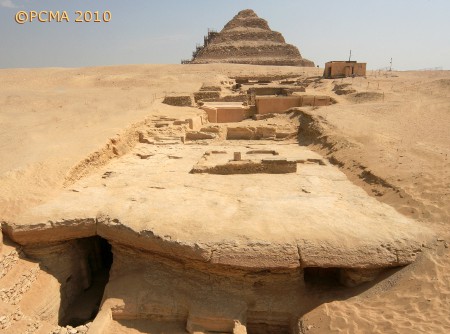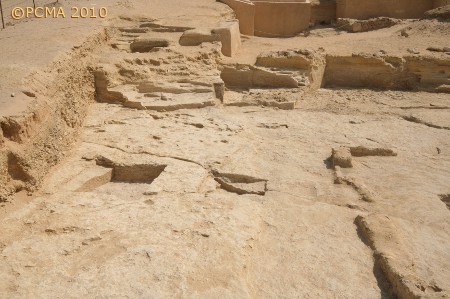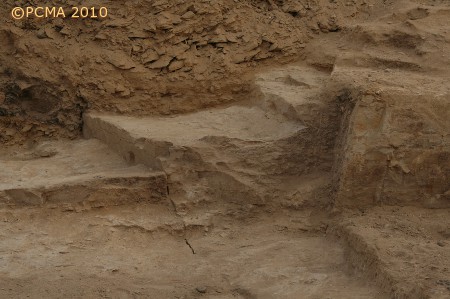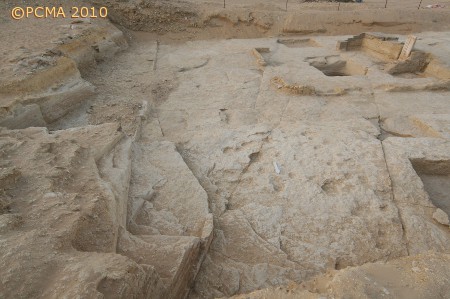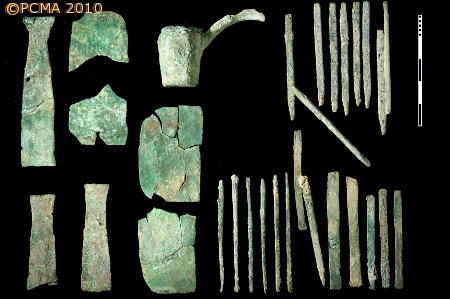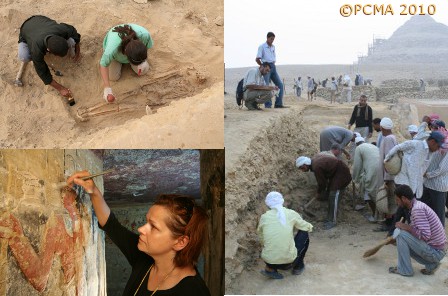Saqqara (Egypt)
Saqqara: The excavation season in 2010
Dates: 15 September–21 October 2010
Team:
Prof. Dr. Karol Myśliwiec, director of the mission (IKSiO PAN)
Dr. Kamil Kuraszkiewicz, egyptologist–archaeologist (Institute of Archaeology, University of Warsaw)
Dr. Fabian Welc, egyptologist, archaeologist (UKSW, Warsaw)
Małgorzata Radomska, archaeologist (IKSiO PAN)
Dr. Jerzy Trzciński, geomorphologist (Institute of Geology, University of Warsaw)
Agnieszka Kowalska, archaeologist (freelance)
Prof. Dr. Andrew Chamberlain (Department of Archaeology, University of Sheffield, UK)
Iwona Kozieradzka-Ogunmakin, osteoarchaeologist (University of Sheffield, UK)
Prof. Dr. Salima Ikram, palaeozoologist (American University in Cairo)
Dr. Teodozja I. Rzeuska, egyptologist/ceramologist (IKSiO PAN)
Dr. Zbigniew Godziejewski, conservator (National Museum in Warsaw)
Magdalena Abramowska, conservator (freelance)
Beata Błaszczuk, architect (freelance)
Jarosław Dąbrowski, photographer (freelance)
The team has been exploring in Saqqara a quarter of the necropolis [Fig. 1] situated between the enclosure wall of the oldest pyramid of the world, the Step Pyramid of the Third Dynasty pharaoh Djoser, and the mysterious “Dry Moat”, which is a gigantic ditch 20 m deep and 40m wide, cut in the rock and surrounding the pyramid enclosure on all four sides. Two burial grounds occupied this area in antiquity: first the tombs of nobles of the Sixth Dynasty (“Lower Necropolis”, about 2300 BC) and then graves that are generally dated to the Ptolemaic period, that is, the last three centuries BC. The objective of the present season was to complete excavations of the two burial horizons and to collect and verify a full set of resources for preparing the fifth volume in the “Saqqara” publication series. This volume will be devoted to the Old Kingdom (= “Lower”) necropolis found in the area investigated by the Polish team (between the enclosure wall of the Step Pyramid and the Dry Moat). Conservation monitoring and current treatment of the painted relief tombs discovered by the expedition in previous seasons proceeded as usual [Fig. 7]; the restorers also worked on preservation and conservation of the finds in the expedition’s stores.
Excavations uncovered ten new burials from the Ptolemaic period. Among them there were four mummies of children. Some of the better preserved mummies were examined by a physical anthropologist in a pioneer study covering a representative group of more than 600 mummies and skeletons. This will be the first analysis of ancient Memphis society based on a comprehensive review of anthropological data from the region.
On the “Lower” of the burial grounds, a rock-cut shaft and burial chamber of a large mastaba from the old Kingdom were examined. The mastaba revealed evidence of multiple use. The grave goods included, among others, 30 copper-alloy miniature tools and vessels, including forms used for ritual purposes [Fig. 6].
The most interesting results came from geoarchaeological research [Fig. 2]. It was demonstrated beyond any doubt that the area which descends in a series of rock terraces from Djoser’s Step Pyramid to the “Dry Moat” received its terraced form in effect of rock-quarrying activities that supplied the necessary building material for the construction of the monumental enclosure wall around the pyramid and the pyramid itself [Figs 3, 4, 5]. Archaeological sources from the lowest layers in the area under excavation, lying directly on the old quarry surface, indicates that once the construction work was finished the surface of the quarry was covered with a layer of mud brick, occasionally even a layer of clay simply, in order to use the area adjoining the pyramid on the west for ritual purposes. The convergence of the high rock step in the surface with the back wall of the underground chamber in which the mission discovered in 2000 a huge relief-decorated ritual harpoon [see Seventy Years of Polish Archaeology in Egypt. The Exhibition Catalogue](symbol of a pharaoh identified with the god Horus) and above it a deposit of wild animal bones which should be associated with Seth, “god of chaos”. There is every reason to think that these remains were part of a complex, consisting of a part aboveground in addition to the subterranean complex, which was built at this particular time. It would have been the stage for rituals connected with the festival of the victory of Horus (Pharaoh) over his enemy Seth symbolized by wild animals. It was two hundred years later, at the end of the Old Kingdom, that the area started to be used for sepulchral purposes. Many tombs of nobles were cut in the rock faces of the old terraces, including the now famous decorated tombs of the vizier Merefnebef and the royal secretary Nyankhnefertem (for Merefnebef, see reports in PAM Journal for the years 1997 (vol. IX), 1998 (vol. X) and 1999 (vol. XI), for Nyankhnefertem, vol. XV [see PAM JOURNAL]. The fourth volume in the “Saqqara” series, published in the fall of 2010, was devoted to the latter tomb.
Geoarchaeological research will continue in the coming season when the mission will focus on excavating the subterranean structures cut into the rock faces on both sides of the “Dry Moat”.
